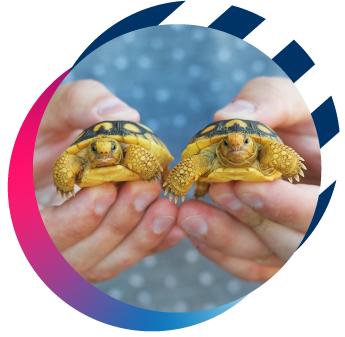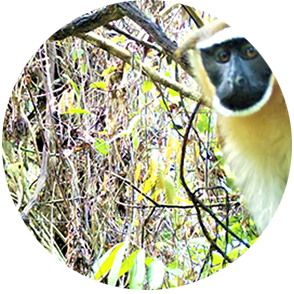
HARRIET L. WILKES HONORS COLLEGE AND HARBOR BRANCH OCEANOGRAPHIC INSTITUTE
Researchers from the Harbor Branch Oceanographic Institute and Harriet L. Wilkes Honors College, conducted a comprehensive health assessment of a group of gopher tortoises at two sites in southeastern Florida, FAU Harbor Branch in Fort Pierce and Loggerhead Park in Juno Beach.
For the study, the team collected blood, nasal and oral samples, along with swabs of the digestive, reproductive and urinary tract openings from 91 tortoises. The samples were analyzed for infectious diseases.
Results of the study, published in the journal Conservation Physiology, showed that overall, 42.9% of all tortoises tested had circulating antibodies to an infectious bacterium that causes upper respiratory tract disease, and 13.2% of tortoises had other forms of physical abnormality noted during physical examination, including limb, eye and shell abnormalities or extra scutes on the tortoise’s shell.
CHARLES E. SCHMIDT COLLEGE OF MEDICINE AND CHARLES E. SCHMIDT COLLEGE OF SCIENCE
In a new study, researchers in the Charles E. Schmidt College of Medicine and the Charles E. Schmidt College of Science, used venom from the Conus nux, a species of sea snail, as a remedy to potentially treat malaria. The snail produces a venomous toxin aimed at counteracting the pathology of severe malaria.
For the study, researchers collected Conus nux samples off the Pacific coast of Costa Rica. The results, published in the Journal of Proteomics, reveal their ability to disrupt protein interactions in the body that directly contribute to the disease.


COLLEGE OF EDUCATION
Researchers in FAU’s College of Education recently explored how Latino male college students make meaning of their masculinity and how this meaning shapes their understanding and performance of leadership.
Participants in the study expressed their understanding of leadership as a strong relationship between the performance of masculinity and the Latino family, as defined by “familismo” — a shared responsibility, solidarity and loyalty within the family construct.
The findings, published in the International Journal of Leadership Education, reveal that “familismo leadership” is a form of leadership practiced by Latino men, which is related to how they define masculinity as a form of strength, how they identify the role of provider as a form of leadership, and how they consider the performance of leadership as direct action.

CHRISTINE E. LYNN COLLEGE OF NURSING
A study led by researchers in the Christine E. Lynn College of Nursing examined the extent of computer ownership, internet access and digital health information use in older African American, Afro-Caribbean, Hispanic American and European American people. Some participants expressed frustration with a lack of access to digital health information, while others critiqued information received from providers.
Results of the study, published in the Journal of Racial and Ethnic Health Disparities, revealed a deep digital health divide within the older population. Participants who were older, less educated, economically disadvantaged and from ethnic groups were up to five times less likely to have access to digital health information than those who were younger, more highly educated and had a higher income.

HARBOR BRANCH OCEANOGRAPHIC INSTITUTE AND I-SENSE
A team of FAU researchers from the Harbor Branch Oceanographic Institute and the Institute for Sensing and Embedded Networks Systems Engineering (I-SENSE) received a three-year, $736,000 grant from the National Aeronautics and Space Administration (NASA), to use satellite images and hydrodynamic modeling to help study the structure and function of the Earth’s system.
The goal is to demonstrate the ability and utility of remote sensing as an observational technique for characterizing the potentially critical, but often neglected, carbon cycle processes related to marine sediments
FAU is one of only 10 universities in the nation and the only university in Florida to receive this grant in support of NASA’s Science Mission Directorate in seeking a better understanding of the ocean’s role in the Earth’s system.

HARBOR BRANCH OCEANOGRAPHIC INSTITUTE
A team of scientists led by Harbor Branch Oceanographic Institute are the first to conduct a multiyear study examining large-scale movements of white-spotted eagle rays in U.S. waters. Along with collaborators from the College of Engineering and Computer Science, the team is also the first to use passive acoustic technology to characterize how white-spotted eagle rays consume hard-shelled mollusk prey, like clams and snails, in a controlled environment.
Between 2016 and 2018, scientists fitted 54 rays with acoustic transmitters and tracked them using collaborative acoustic telemetry networks. Results of the study, published in the journal Marine Biology, reveal striking differences in travel patterns on the Atlantic coast eagle rays that preferred to be homebodies compared to the Gulf coast eagle rays that wanted to roam the ocean floor.
To capture their shell crushing sound, the scientists monitored underwater sounds using acoustic recorders. Their findings published in the Journal of Experimental Marine Biology and Ecology, reveal that using this technology, prey types could be distinguished based on acoustic features and they could determine what a predator is eating based on how it sounds.
COLLEGE OF SOCIAL WORK AND CRIMINAL JUSTICE
Sameer Hinduja, Ph.D., a professor in the College of Social Work and Criminal Justice, and co-director of the Cyberbullying Research Center, recently released results of the first-ever nationally representative survey focused on instances of cyberbullying among tweens, ages 9 to 12. The study, launched as part of the Cartoon Network’s award-winning Stop Bullying: Speak Up initiative, found that one in five tweens have experienced cyberbullying in some way: either by witnessing cyberbullying having been cyberbullied themselves or by cyberbullying other teens.
In response to the research, Cartoon Network created its first-ever, parent-targeted social content illuminating key findings from the study along with tips from the Cyberbullying Research Center for parents to help their children identify and stand up to cyberbullying.


COLLEGE OF BUSINESS AND TECH RUNWAY
ShipMonk, a South Florida company created by FAU College of Business graduate Jan Bednar, left, recently secured $290 million in financing from Boston-based Summit Partners.
Summit will become a minority investor in the business, which will use the capital for research and development, hiring, international expansion and other pursuits. Bednar originally funded the fledgling business with prize money from winning such contests as FAU’s Business Plan Competition and with assistance from FAU Tech Runway.
ShipMonk employs 1,000 people and plans to add 500 more in the next year. It expected to generate more than $140 million in revenue in 2020, achieving annual growth in excess of 100%.

COLLEGE OF BUSINESS AND THE FAU WAVE
Paris Prince, left, and Aiden Natalie, are two students who earned top spots in two of FAU’s annual business-related competitions. These contests award budding entrepreneurs seed money for business ventures.
Natalie is an undergraduate in the College of Business, and took first place in the 13th annual Business Plan Competition for his Marine Connex app, which helps boaters find available services near them. He built a prototype for the competition and plans to use the prize money to further develop the product and test market it. His app also won second place in the Division of Research’s annual FAU Wave competition. Natalie is also now a part of Tech Runway’s Venture Class 9. He is the founder and CEO of Marine Connex.
Paris Prince, a student at FAU High School and in the Charles E. Schmidt College of Science, took second-place in the annual Business Plan Competition, for her creation of SPods, an innovation that allows users to wash hands without the use of any external water supply. Her invention also won first place in the FAU Wave competition for the second consecutive year, as well as first place in the state’s annual MuniMod competition.

COLLEGE OF ENGINEERING AND COMPUTER SCIENCE
Borko Furht, Ph.D., and Hari Kalva, Ph.D., both professors in the College of Engineering and Computer Science, recently built a new novel technology that dramatically shrinks video files into smaller sizes, while improving the viewing experience. The patent-pending innovation was recently acquired by Japanese industry giant Mitsubishi Electric Corporation.
The new technology provides faster, more accurate estimates of motion in a video. A single background image can be matched and placed into several frames, saving file space.

DOROTHY F. SCHMIDT COLLEGE OF ARTS AND LETTERS
Using non-invasive research and no-flash camera traps from 2014 to 2019, Daniel Alempijevic, a doctoral student, and Kate Detwiler, Ph.D., an associate professor, both in the Dorothy F. Schmidt College of Arts and Letters, captured images of the endangered dryas monkey in the African Democratic Republic of the Congo.
Dryas monkeys weigh between five to seven pounds, and live in the dense vegetation of the Lomami National Park, making them difficult to detect. The scientists’ findings, published in Oryx — The International Journal of Conservation, indicate that Lomami National Park and its buffer zone contain the greatest extent of the species’ known range, and Lomami is the only national park with a confirmed population.
